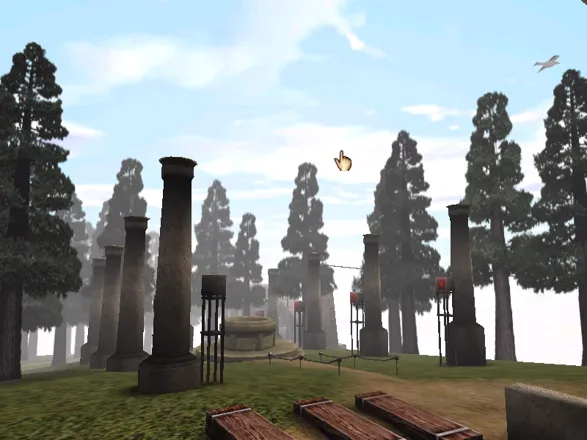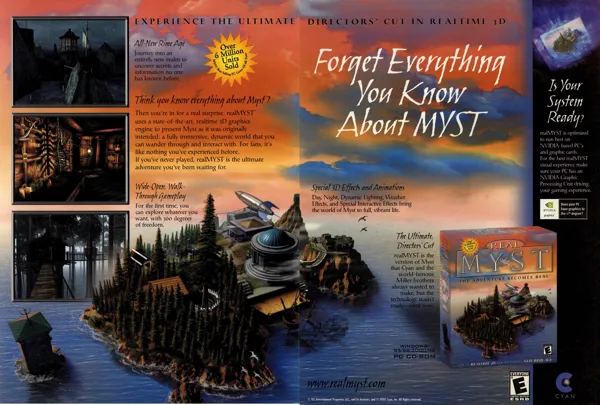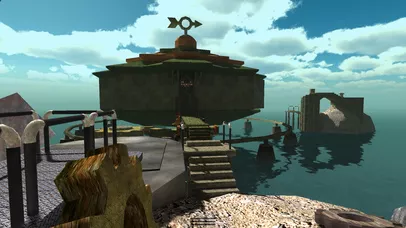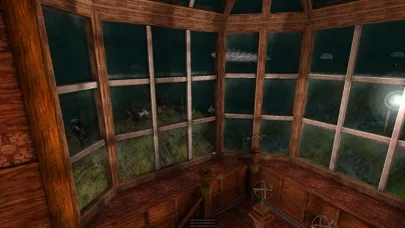Real Myst
Description official descriptions
The original Myst is revamped for the new millennium, in 3D: dynamic and fully interactive with day and night condition cycles, changing weather, and real-time lighting effects. Unlike in the original version, with its "screen by screen" navigation and pre-rendered images that represented locations, Real Myst allows the player to physically explore the game's world and includes a fully rotatable camera.
The remake also adds a fifth "Age" (a world created by the power of human imagination), called the Rime Age, and a new available ending.
Groups +
Screenshots
Promos
Videos
Add Trailer or Gameplay Video +1 point
See any errors or missing info for this game?
You can submit a correction, contribute trivia, add to a game group, add a related site or alternate title.
Credits (Windows version)
108 People (93 developers, 15 thanks) · View all
| Original Design | |
| Director | |
| Producer | |
| Project Manager | |
| Production Lead | |
| CG Art and Animation | |
| Core Technology Development | |
| [ full credits ] | |
Reviews
Critics
Average score: 76% (based on 18 ratings)
Players
Average score: 4.1 out of 5 (based on 44 ratings with 3 reviews)
A masterpiece of sight, sound and of the brain
The Good
I have to admit, I wasn't always that enthusiastic with Myst.
I used to belong to a school of thought that shunned the idea of an adventure game having no inventory - hence very little to no inventory puzzles, barely any NPCs and thus scant to zero dialogues, with minimal scenery interaction and feedback from the protagonist. Add to that an ostensibly absent story and plot, and you get a prejudice.
I'm not saying I hated Myst, oh no. I tried my best to eschew the Myst hate bandwagon, it seemed unfair for me to dislike a game before I even gave it a try. It's just that it was at the bottom of my priority list, and so I never got to playing it. Up until recently.
I'm going to present a few points detractors of the game constantly raise as arguments against it, and bring my own counter-points:
"The game is lifeless and bland. There's no one to talk to." This is far from the truth. Let's start with the fact that you do get to meet at least a couple of characters in the game directly. True, interaction with them is very limited, and I'm talking about very few characters indeed. But people who raise this criticism fail to understand that this game doesn't need a plethora of characters to accomplish its goal of total immersion. The game is filled with such vivid, lively scenery, presented in real time 3D renders, that sometimes you just want to reach your hand to the monitor and touch it. It's full of impressive weather effects, beautiful landscapes and plenty of detailed flora and fauna. The movement is free roaming and smooth. How's that bland and lifeless? Oh, and don't let me get going on the sounds and music. Besides, you get to know some of the characters and events vicariously through the various books and locations. That's more than enough for a game like Myst. You can say that the game itself is the characters (i.e. The Isle of Myst and the Ages you get to visit), the engaging atmosphere its plot.
"The puzzles are boring and unimaginative." That's light years from the truth. Who said there has to be an inventory in an AG? If anything, it makes the game much more realistic. In truth, the puzzles in Myst are fascinating, organic and integral of the environment and architecture. I can't think of many games prior to Myst whose puzzles can be described as atmospheric and organic. You've got to admire its originality, and the Millers' unabashed courage in creating a game that dared to be different. You don't need any previous knowledge or skill to solve the puzzles. They're all logical to the game's world, and your challenge is simply to apply that logic. Just be observant of your surroundings. Some of these structures and mechanisms are surreal and out there, so it takes some cerebral activity to figure them out, but none too difficult. In fact, I found the puzzles in Myst slightly too easy, if I do say so myself. That could be because I'm very experienced with AGs, so I guess they're just right for the novice/average player. Because they're so well ingrained in the game's surroundings, a smart approach is to think realistically and logically, consistently with the game's design.
"This game has no plot, what kind of an AG is this?"
True, the plot isn't exactly the strongest point of the game. But as mentioned in this review, there are books and letters from which you can extract some of the mysterious story.
To me, the Millers wanted the plot to be very subtle and delicate in order to emphasise the mystery. It's not called Myst for nothing, y'know. And indeed, the game's grandeur lies in its humility and lack of pretense. Anyone who's got an iota of curiosity in them would be excited at the prospect of
investigating the secrets of every nook and cranny in the game's worlds. In this case, the minimal nature of the story is its strength. And need I say a picture speaks a thousand words? :P
Myst makes you feel as if what you see on your computer monitor truly exists. You soak in the gorgeous visuals and sounds, and you got your story. More ever, there's a nice little twist towards the very end of the game. Not entirely unexpected, but nevertheless enjoyable.
As a side note, in addition to the documents found in the game, the Millers authored at least three books taking place in the Myst universe, incorporating all the characters and events of the games, and then some. You might want to check those out, though it's not required in order to enjoy the game.
The Bad
Not really 'bad', but sometimes it was easy to miss a few hotspots and get lost. The cursor didn't always indicate interactivity, which was a bit confusing.
There's one puzzle involving musical keys with sliders that are very sensitive, and so you have to be extremely precise.
The game lacks captions. I find the inability to activate subtitles a fault in any game, but since Myst has very little spoken dialogue anyway, it wasn't a big deal.
The Bottom Line
Approach Myst with an open mind. Don't be dismayed by the empty, baseless criticisms, which are really prejudices.
Don't be afraid of its solitary design - the solitude just enhances its appeal, as it grants a sense of tranquility and clarity of mind, which are needed to solve the ambient puzzles. Enjoy the clear, clean and minimal interface, which allows you to seamlessly plunge into the game.
Just "be there" and relish the logically realistic structures, savour the beauty of nature and technology. Submit, and let the game draw you in.
Windows · by Tal Cohen (31) · 2008
The ultimate way to experience Myst.
The Good
Myst is no longer just a slideshow with an occasional sound. This game is in full 3D, with dynamic weather, passing time, and incredible ambience. Everything from the original Myst is here - even the hidden easter eggs (as well as a couple of new ones), and it's all enhanced for modern computers. This is a great way to "get lost" in another world.
The Bad
Outside of the new Rime Age, there is nothing else new about this edition of Myst. All the puzzles are exactly the same as they were before. It's really only worth playing this game again to see all the new graphics, or just to explore the ages and see what things look like. Newcomers, however, will be greatly rewarded.
The Bottom Line
RealMyst is the greatest edition of Myst to hit the market, taking nearly everything that was good about the original and expanding upon it.
Windows · by wildweasel (36) · 2006
The Good
Note: this review refers to the original version of Myst as well as the new features introduces by this remake.
When Myst was released back in 1993, it polarized opinions. This strange game greeted players with beautifully drawn images depicting confusing mechanical puzzles and not much else. Inventory, characters to talk to, text feedback - all familiar staples of adventure games - were inconspicuously missing. Subsequent development of the genre even went as far as dividing fans into opposing camps: those who resented and lamented the game's meditative nature and its lack of interactivity, and those who saw in it a higher ideal of more sophisticated puzzle-solving.
In order to understand and enjoy Myst, one must abandon all preconceptions and let the game do its job. The difficulty of the puzzles, the low interactivity, the absence of text - all of that was deliberate, as part of the ideals the creators of Myst had in mind. For me, every game concept is as valid as any other, provided it was created with soul and not out of sheer calculation. To love or to hate the kind of experience Myst offers is entirely a matter of taste. But it cannot be denied that this experience is unique.
The idea behind all those omissions was to immerse the player in the atmosphere of loneliness. Puzzles had to be tough in order to make the world feel more alien and, in a way, hostile. Interactivity had to be low because this way the game could feel sufficiently "empty", making the player feel like a complete stranger in a bizarre world. For the same reason, in-game text descriptions were removed. The player was left alone with the graphics that represented the world. Those graphics were now the focus, the main aspect of the game. The vision of the designers was to create a world that would be beautiful and immersive just because it looked this way, without requiring anything else.
This vision was most certainly ahead of its time. Today, in the age of advanced 3D graphics, many games are developed with a specific idea of making the game world as appealing to the senses as possible. This was also what Myst wanted to be; but in its time, there was no other adventure game that tried to do that. Adventure games were cerebral, not sensual. People didn't play them because they wanted to travel into a virtual reality so beautiful that it would be enough to look at it in order to enjoy the game.
However, Myst didn't quite succeed at attaining its lofty goal. Rendering and scanning pretty pictures was not really enough to make up for lack of activity. There had to be some sort of an engine to tie it all together. Under a Killing Moon was a better realization of this vision, at least from a purely graphical point of view. The twisted irony was that adventure games didn't follow the vision of Myst, but only its faulty execution.
This is exactly what the remake (very fittingly called Real Myst) attempted to correct - and the results are spectacular. Real Myst is so much better than the original version that you can't be sure to dislike it even if you hated the old Myst. As a matter of fact, I used to hate it, and it was thanks to this remake that I changed my opinion and learned to appreciate it. Real Myst contains absolutely everything the original release had, eliminating at the same time its biggest drawback that ruined the game for many people: the inability to be physically immersed in its world. The remake is done in real-time 3D, with full camera controls, which means that you can physically go wherever you like and look at anything from any angle. I can't even begin to describe properly how much it enhances the experience. Finally, the intricate world of Myst comes to life: we are able to "feel" it, to be in it.
Before you think that the graphics lost some detail because of the transition to 3D, let me assure you that is not the case. Every single location, every single object in Real Myst is as beautiful and as detailed as they were before - actually, most of them appear even more detailed, and definitely much more lifelike. In fact, many details were added: for example, you can see birds flying over the sea, clouds moving, etc. There is a real day and night cycle as well as weather changes (including rain and snow) - all presented with magnificent effects. The artistic design and the very high technical level of the graphics make Real Myst one of the best-looking games I've come across - of course, relative to the time. At the time it was released, the game was visually groundbreaking, able to compete with contemporary first-person shooters. There is also a whole new "Age" to explore in this version, so Real Myst becomes a remake and an add-on in one.
Otherwise, the game is identical to the original version - which means it puts you face to face with the notoriously difficult puzzles. Those are hard mainly because they are not presented as clear tasks. They appear in the game without drawing immediate attention to them, without explaining why they should be solved. It is useless to solve them by trial and error. You will never solve the puzzles of Myst if you just walk around and click on everything, hoping for something to happen. Unlike many other games with similar claims, Myst does require the player to think. Recall your favorite classic adventure game - how many puzzles in it were really thinking challenges? Nearly all of them were solved by experimenting with objects. The puzzle system of Myst, on the other hand, is not prone to abuse. The puzzles are hard, but they all have clues. Those clues are subtly placed, and looking for them is what makes the gameplay exciting. Every puzzle has to be researched, understood, and only then it will be possible to think of its solution.
The best part of those puzzles is that most of them are connected to each other. Nearly every puzzle is unsolvable if you just interact with it without any previous knowledge. They are not self-sufficient the way they were in 7th Guest. That's where the gameplay superiority of Myst is clearly manifested. The puzzles here form an entire system: most of the time, you'll have to understand the function of a device, find a clue for its operation, and understand its meaning. For that, you'll have to explore other parts of the world, find other devices, etc. Most of the puzzles are surprisingly clear and logical, even though they require you to be very patient and attentive. Myst uses graphics and sounds to provide clues; many clues are also contained in the library, the central "hub" of the game, where abundance of text compensates for its lack elsewhere.
It is not true that Myst has no story. It can be argued that the world itself is the star of the narrative, replacing plot with its extravagant presence and enigmatic design. However, as cryptic and as well-hidden as it is, the story is still there. The process of hunting for the red and blue pages, getting rid of the mysterious "static" in the books and finally making the sons of Atrus speak clearly is exiting enough, and the story always retains the aura of mystery, true to the game's title.
The Bad
Myst is far from being a game for everybody. More than that, it can appear pointless until you manage to enter the right "mode" enabling you to enjoy it. This particularly applies to the original version; but even the remake, while greatly increasing immersion, won't convert most those who can't feel the magic. Interestingly enough, it seems that casual players were more fascinated by Myst than hardcore adventurers, many of whom loathed what it did to their beloved genre.
While I acknowledge the important achievements of the game, I can't say I was happy about every decision it made. I don't think proper text feedback would have impaired the designers' plans to immerse the player solely through graphics. Particularly the initial release exhibits lack of stimulation as it throws you into what appears at first glance to be a slide show of exotic pictures. There is something chillingly discomforting about the game, and a slight feeling of artificiality accompanies you on your journey. At least the remake removes the shackles of the strangulating perspective, no longer requiring you to awkwardly jump from screen to screen; but it cannot get rid of a certain tinge of sterility as you pace between mechanical contraptions, yearning for human contact or at least some more accommodating vistas.
The puzzles are not all brilliant. Naturally, you'll have to make concessions to genre requirements if you wish to enjoy them in the first place - here perhaps more so than in most other adventure games. It is futile to look for real-life logic in the fact that every vital piece of information in the game is protected by mentally stimulating, yet utterly contrived tasks. Some of those, however, overly complicate the procedure without an even halfway plausible reason. The early puzzle with the markers as well as the confusing tasks appearing towards the end of the game are examples of such overkill in needless complexity.
The Bottom Line
Myst was a bold, intellectually challenging game with aspirations that were ahead of its time. With the advent of its remake, the time has finally come to truly realize its vision. Having everything the original version had, while getting rid of its rather aggravating engine-related weakness, Real Myst is the definitive version of this historical title. Try to see and enjoy it for what it is: not an adventure game following an established tradition, but one that seeks other ways and means to challenge and immerse, succeeding in its unorthodox methods.
Windows · by Unicorn Lynx (181664) · 2014
Trivia
Inside the clock tower on Myst Island, the name "Doug" is written on the ceiling; an apparent reference to Doug McBride of Cyan.
Analytics
Upgrade to MobyPro to view research rankings and price history! (when applicable)
Related Sites +
-
Zarf's Review
A review of Real MYST by Anrew Plotkin, which compares the 3D remake to the original Myst and discusses the overall design in both (July, 2002). -
realMyst: Mini Guide to Rime
Solution guide for the new age, Rime (archived link).
Identifiers +
Contribute
Are you familiar with this game? Help document and preserve this entry in video game history! If your contribution is approved, you will earn points and be credited as a contributor.
Contributors to this Entry
Game added by Kartanym.
iPhone added by Cantillon. iPad added by Techademus. Android added by Evolyzer. Macintosh added by Kabushi.
Additional contributors: Jeanne, wildweasel, Zeppin.
Game added November 24, 2000. Last modified July 26, 2024.






















